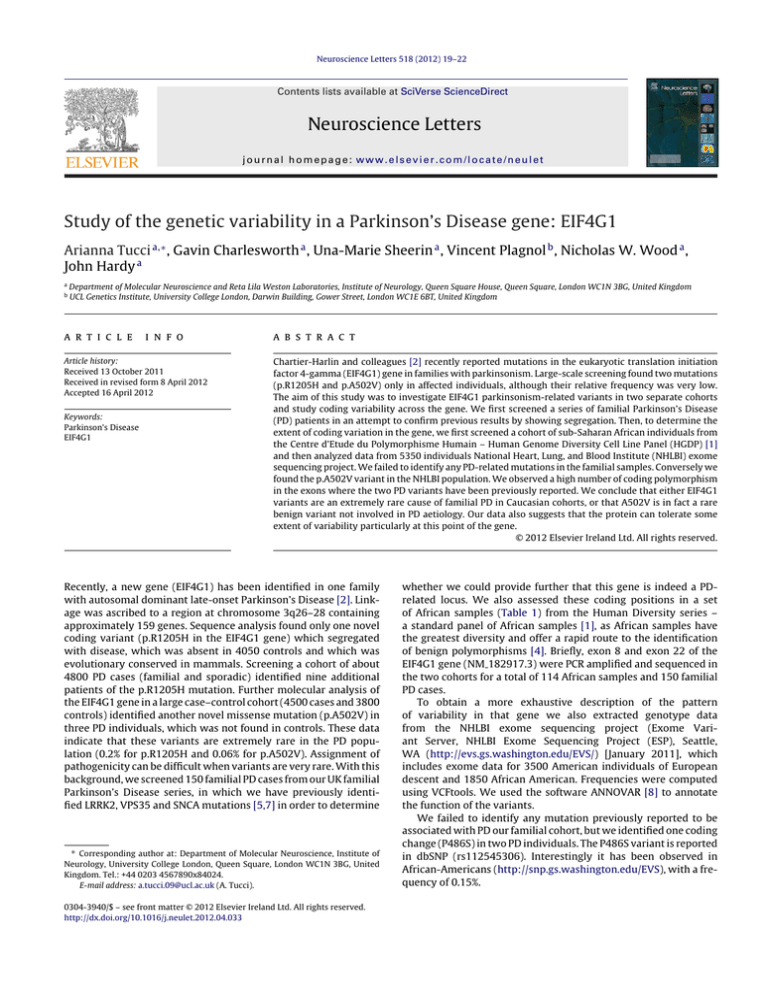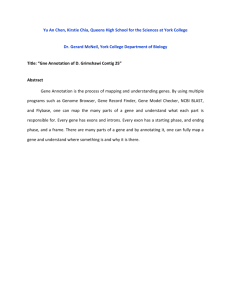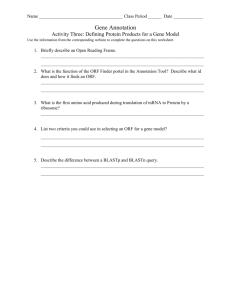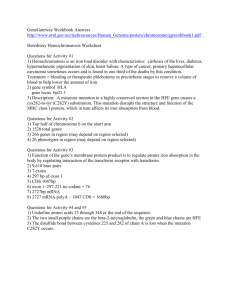
Neuroscience Letters 518 (2012) 19–22
Contents lists available at SciVerse ScienceDirect
Neuroscience Letters
journal homepage: www.elsevier.com/locate/neulet
Study of the genetic variability in a Parkinson’s Disease gene: EIF4G1
Arianna Tucci a,∗ , Gavin Charlesworth a , Una-Marie Sheerin a , Vincent Plagnol b , Nicholas W. Wood a ,
John Hardy a
a
b
Department of Molecular Neuroscience and Reta Lila Weston Laboratories, Institute of Neurology, Queen Square House, Queen Square, London WC1N 3BG, United Kingdom
UCL Genetics Institute, University College London, Darwin Building, Gower Street, London WC1E 6BT, United Kingdom
a r t i c l e
i n f o
Article history:
Received 13 October 2011
Received in revised form 8 April 2012
Accepted 16 April 2012
Keywords:
Parkinson’s Disease
EIF4G1
a b s t r a c t
Chartier-Harlin and colleagues [2] recently reported mutations in the eukaryotic translation initiation
factor 4-gamma (EIF4G1) gene in families with parkinsonism. Large-scale screening found two mutations
(p.R1205H and p.A502V) only in affected individuals, although their relative frequency was very low.
The aim of this study was to investigate EIF4G1 parkinsonism-related variants in two separate cohorts
and study coding variability across the gene. We first screened a series of familial Parkinson’s Disease
(PD) patients in an attempt to confirm previous results by showing segregation. Then, to determine the
extent of coding variation in the gene, we first screened a cohort of sub-Saharan African individuals from
the Centre d’Etude du Polymorphisme Humain – Human Genome Diversity Cell Line Panel (HGDP) [1]
and then analyzed data from 5350 individuals National Heart, Lung, and Blood Institute (NHLBI) exome
sequencing project. We failed to identify any PD-related mutations in the familial samples. Conversely we
found the p.A502V variant in the NHLBI population. We observed a high number of coding polymorphism
in the exons where the two PD variants have been previously reported. We conclude that either EIF4G1
variants are an extremely rare cause of familial PD in Caucasian cohorts, or that A502V is in fact a rare
benign variant not involved in PD aetiology. Our data also suggests that the protein can tolerate some
extent of variability particularly at this point of the gene.
© 2012 Elsevier Ireland Ltd. All rights reserved.
Recently, a new gene (EIF4G1) has been identified in one family
with autosomal dominant late-onset Parkinson’s Disease [2]. Linkage was ascribed to a region at chromosome 3q26–28 containing
approximately 159 genes. Sequence analysis found only one novel
coding variant (p.R1205H in the EIF4G1 gene) which segregated
with disease, which was absent in 4050 controls and which was
evolutionary conserved in mammals. Screening a cohort of about
4800 PD cases (familial and sporadic) identified nine additional
patients of the p.R1205H mutation. Further molecular analysis of
the EIF4G1 gene in a large case–control cohort (4500 cases and 3800
controls) identified another novel missense mutation (p.A502V) in
three PD individuals, which was not found in controls. These data
indicate that these variants are extremely rare in the PD population (0.2% for p.R1205H and 0.06% for p.A502V). Assignment of
pathogenicity can be difficult when variants are very rare. With this
background, we screened 150 familial PD cases from our UK familial
Parkinson’s Disease series, in which we have previously identified LRRK2, VPS35 and SNCA mutations [5,7] in order to determine
∗ Corresponding author at: Department of Molecular Neuroscience, Institute of
Neurology, University College London, Queen Square, London WC1N 3BG, United
Kingdom. Tel.: +44 0203 4567890x84024.
E-mail address: a.tucci.09@ucl.ac.uk (A. Tucci).
0304-3940/$ – see front matter © 2012 Elsevier Ireland Ltd. All rights reserved.
http://dx.doi.org/10.1016/j.neulet.2012.04.033
whether we could provide further that this gene is indeed a PDrelated locus. We also assessed these coding positions in a set
of African samples (Table 1) from the Human Diversity series –
a standard panel of African samples [1], as African samples have
the greatest diversity and offer a rapid route to the identification
of benign polymorphisms [4]. Briefly, exon 8 and exon 22 of the
EIF4G1 gene (NM 182917.3) were PCR amplified and sequenced in
the two cohorts for a total of 114 African samples and 150 familial
PD cases.
To obtain a more exhaustive description of the pattern
of variability in that gene we also extracted genotype data
from the NHLBI exome sequencing project (Exome Variant Server, NHLBI Exome Sequencing Project (ESP), Seattle,
WA (http://evs.gs.washington.edu/EVS/) [January 2011], which
includes exome data for 3500 American individuals of European
descent and 1850 African American. Frequencies were computed
using VCFtools. We used the software ANNOVAR [8] to annotate
the function of the variants.
We failed to identify any mutation previously reported to be
associated with PD our familial cohort, but we identified one coding
change (P486S) in two PD individuals. The P486S variant is reported
in dbSNP (rs112545306). Interestingly it has been observed in
African-Americans (http://snp.gs.washington.edu/EVS), with a frequency of 0.15%.
20
A. Tucci et al. / Neuroscience Letters 518 (2012) 19–22
Table 1
Number of African samples studied per population and geographic regions.
No. of samples
35
15
12
7
26
24
8
Population
Geographic origin
Biaka Pygmy
Mbuti Pygmy
Bantu N.E.
San
Yoruba
Mandenka
Bantu S.E. Pedi
Central African Republic
Democratic Republic of Congo
Kenya
Namibia
Nigeria
Senegal
South Africa
We identified six non-synonymous changes in exon 8
and in exon 22 in the African individuals. Of these, one
is a novel change (P382L), the others are variants recently
reported in dbSNP and found mainly in African populations
(http://snp.gs.washington.edu/EVS). To predict the impact on protein function of these non-synonymous variants, we performed an
in silico analysis using the software PolyPhen and SIFT [6] and all
were predicted to be benign (Table 2).
Analysis of the NHLBI samples allowed us to detect the
A502V variant in two European-American individuals (frequency
of 0.02%). We identified 95 nonsynonymous SNP over 32 exons
Table 2
EIF4G1 coding variant detected in the African cohort (NM 182917.4).
Nucleotide change
Protein change
SNP accession number
Frequency
Population
Effect (SIFT)
c.870G>A
c.913C>T
c.932A>G
c.1145C>T
c.1429G>A
c.3918G>A
M290I
R305C
Y311C
P382L
E477K
R1216H
rs144947145
rs116508885
rs16858632
NA
rs145228718
rs34086109
0.01
0.01
0.03
0.004
0.004
0.004
San, Bantu SE
Youruba
Bantu SW, Bantu NE, Yoruba, Mandenka
San
Mandenka
Biaka Pygmy
Tolerated
Tolerated
Tolerated
Tolerated
Tolerated
Tolerated
Table 3
EIF4G1 coding variants present in NHLBI Exome Sequencing Project (NM 182917.4). EA = European American population. AA = African American population.
Nucleotide change
Protein change
c.C71T
c.C167G
c.C211T
c.282C>G
c.451C>G
c.481A>G
C.602G>A
C.608C>T
C.704G>A
C.731G>A
C.779C>T
c.821C>T
c.870G>A
c.913C>T
c.914G>A
c.926A>G
c.932A>G
c.1001A>C
c.1013C>T
c.1036C>A
c.1054G>T
c.1063A>G
c.1064C>T
c.1142C>G
c.1256G>T
c.1294A>G
c.1298C>T
c.1309A>G
c.1316C>A
c.1331C>T
c.1352C>A
c.1429G>A
c.1456C>T
c.1505C>T
c.1610C>T
c.1648G>C
c.1679G>A
c.1696C>T
c.1700C>A
c.1754A>C
c.1801T>C
c.1831C>T
c.1980A>G
c.1982A>G
c.2096G>C
c.2114C>G
c.2152G>C
c.2225C>T
P24L
A56G
P71S
I94M
V151L
A161T
R201H
A203V
R235Q
R244Q
S260L
P274L
M290I
R305C
R205H
E309G
Y311C
P334Q
S338F
Q346K
A352S
T355A
T355I
A381G
S419I
M432V
A433V
I437V
S439Y
T444M
P451Q
E477K
P486S
A502V
A537V
A550P
G560D
R566C
P567H
E585A
W601R
R611C
I660M
N661S
G699A
S705C
A718P
T742M
SNP accession number
rs113810947
rs13319149
rs34838305
rs144543953
rs147855566
rs139626338
rs144947145
rs116508885
rs151151194
rs16858632
rs139021806
rs142095694
rs138207269
rs2178403
rs145998921
rs144222028
rs148709174
rs143014570
rs147419996
rs145228718
rs112545306
rs111290936
rs111924994
rs149685875
rs145521479
rs140212150
rs145247318
rs145780534
rs141054452
rs111396765
rs147678593
Frequency (EA)
Frequency (AA)
Exon
0.000142
0.000142
0.000285
0
0.000143
0.996722
0.000427
0.000142
0.000142
0.000142
0.000142
0
0
0
0.000142
0.000142
0.000427
0.000285
0
0
0.000142
0
0
0.000142
0
0.759544
0.000142
0
0.000142
0
0.000142
0
0.00057
0.000285
0
0.001994
0.000142
0.000142
0
0
0
0
0.000142
0.000142
0.000142
0.000142
0.001567
0
0
0
0
0.000268
0
0.999465
0
0
0.000268
0
0
0.000268
0.001338
0.00321
0.000268
0
0.059658
0
0.000268
0.000268
0
0.000268
0.000268
0
0.000535
0.943553
0
0.000268
0
0.000268
0
0.000268
0.000803
0
0.000268
0.000535
0
0.000268
0.000268
0.000268
0.000268
0.000268
0
0
0
0
0.000268
0.004013
2
3
3
3
5
5
6
6
8
8
8
8
8
8
8
8
8
8
8
8
8
8
8
8
8
8
8
8
8
8
8
8
8
8
10
10
10
10
10
10
11
11
12
12
13
13
13
13
A. Tucci et al. / Neuroscience Letters 518 (2012) 19–22
21
Table 3 (Continued)
Nucleotide change
Protein change
c.2276A>G
c.2278G>C
c.2386A>G
c.2419A>G
c.2488A>T
c.2612A>C
c.2671A>G
c.2882A>G
c.3187C>T
c.3221C>T
c.3343C>T
c.3428A>G
c.3482G>A
c.3511C>T
c.3529C>T
c.3580C>T
c.3584G>A
c.3592C>T
c.3617G>A
c.3649C>T
c.3650G>A
c.3652G>A
c.3686C>T
c.3688C>G
c.3701T>C
c.3743A>G
c.3773A>G
c.3935C>T
c.3937A>G
c.3988A>G
c.4067T>C
c.4068G>C
c.4081A>G
c.4106C>T
c.4184C>T
c.4201G>A
c.4229A>C
c.4259A>G
c.4292C>T
c.4300C>T
c.4379G>A
c.4399G>A
c.4433C>T
c.4454C>T
c.4486A>T
c.4712C>T
c.4772G>A
Q759R
D760H
K796E
I807V
T830S
E871A
I891V
N961S
R1063C
T1074I
R1115C
Q1143R
R1161H
R1171C
R1177C
R1194W
S1195N
R1198W
R1206H
R1207C
R1217H
G1217R
P1299L
P1230A
L1234P
K1248R
N1258S
S1312F
T1313A
M1330V
M1356T
M1356I
R1361G
P1369L
T1395M
G1401R
E1410A
E1420G
S1431L
P1434S
R1460Q
A1467T
T1478M
T1485M
T1496S
A1571V
R1591H
SNP accession number
rs142947014
rs62287499
rs111500185
rs191888688
rs146433145
rs150054202
rs145414660
rs139135683
rs141684202
rs113388242
rs112176450
rs34086109
rs138270117
rs35629949
rs2230570
rs73053766
rs144570332
rs112809828
rs144059151
rs145975905
rs139793721
rs142064428
rs112441721
rs149821418
rs141776790
rs147696097
rs148270724
rs141379472
rs144462594
in total (NM 182917.3). Of note, 36 of them are located in
exon 8 and exon 22 (Table 3). To investigate coding variability across the EIF4G1 gene we extracted the data from the
NHLBI dataset and computed the average number of pairwise
amino acid differences between two randomly selected EuropeanAmerican haplotypes from the NHLBI dataset (Methods). On
average two such EIF4G1 sequences diverge by 0.45 aminoacids.
82% of this variability (0.37 amino-acid differences) locates to exon
8, where the A502V lies. 9.8% of this variability locates to exon
22 (0.098 amino-acid differences). Combined with the identification of six coding variants in exons 8 and 22 in African samples,
these data are consistent with a more limited selective pressure
and a higher sequence variability in this region of the EIF4G1
protein.
These data, combined with the presence of the A502V in
the NHLBI population with 0.02% frequency and our failure to
identify any PD mutation carrier in our familial cohort, are consistent with the interpretation that either EIF4G1 variants are
an extremely rare cause of familial PD in Caucasian cohorts, or
that A502V is in fact a rare benign variant not involved in PD
aetiology.
Frequency (EA)
Frequency (AA)
Exon
0.000142
0.000142
0
0.000427
0.000285
0.000142
0
0
0.000142
0.000142
0
0
0.000427
0
0
0.000142
0.000142
0
0.000285
0.000143
0
0
0
0.005842
0.021937
0.000142
0
0
0.000142
0.000285
0.000855
0.000285
0
0
0
0.000142
0
0
0.000142
0.000142
0.000142
0.000142
0.000142
0.000142
0
0.000142
0.000142
0
0
0.000268
0
0
0
0.000268
0.000268
0
0
0.000268
0.000268
0
0.000268
0.000268
0
0
0.000268
0
0
0.010433
0.000268
0.000268
0.001606
0.080257
0
0.001873
0.000268
0.000803
0
0
0
0.000268
0.000803
0.000268
0.000803
0.000268
0.000268
0.000268
0
0
0
0
0
0.000268
0
0
14
14
14
14
15
15
16
17
19
19
21
21
22
22
22
22
22
22
22
22
22
22
23
23
23
23
23
24
24
25
25
25
25
26
27
27
27
27
28
28
28
29
29
29
29
31
31
Role of the funding source
This study was supported by Parkinson’s Disease Society (AT)
and by the Medical Research Council and Wellcome Trust Disease
Centre (grant WT089698/Z/09/Z). DNA extraction work was undertaken at University College London Hospitals, University College
London, who received a proportion of funding from the Department of Health’s National Institute for Health Research Biomedical
Research Centres funding.
Disclosure statement
Arianna Tucci, Gavin Charlesworth, Una-Marie Sheerin, Vincent
Plagnol, Nick Wood, John Hardy report no disclosures.
Acknowledgements
We thank all patients and all families who supported the donation of tissue for research.
22
A. Tucci et al. / Neuroscience Letters 518 (2012) 19–22
References
[1] H.M. Cann, C. de Toma, L. Cazes, M.F. Legrand, V. Morel, L. Piouffre,
J. Bodmer, W.F. Bodmer, B. Bonne-Tamir, A. Cambon-Thomsen, Z. Chen, J. Chu,
C. Carcassi, L. Contu, R. Du, L. Excoffier, G.B. Ferrara, J.S. Friedlaender, H. Groot,
D. Gurwitz, T. Jenkins, R.J. Herrera, X. Huang, J. Kidd, K.K. Kidd, A. Langaney, A.A.
Lin, S.Q. Mehdi, P. Parham, A. Piazza, M.P. Pistillo, Y. Qian, Q. Shu, J. Xu, S. Zhu,
J.L. Weber, H.T. Greely, M.W. Feldman, G. Thomas, J. Dausset, L.L. Cavalli-Sforza,
A human genome diversity cell line panel, Science 296 (2002) 261–262.
[2] M.C. Chartier-Harlin, J.C. Dachsel, C. Vilariño-Güell, S.J. Lincoln, F. Leprêtre,
M.M. Hulihan, J. Kachergus, A.J. Milnerwood, L. Tapia, M.S. Song, E. Le Rhun,
E. Mutez, L. Larvor, A. Duflot, C. Vanbesien-Mailliot, A. Kreisler, O.A. Ross,
K. Nishioka, A.I. Soto-Ortolaza, S.A. Cobb, H.L. Melrose, B. Behrouz,
B.H. Keeling, J.A. Bacon, E. Hentati, L. Williams, A. Yanagiya,
N. Sonenberg, P.J. Lockhart, A.C. Zubair, R.J. Uitti, J.O. Aasly, A. Krygowska-Wajs,
G. Opala, Z.K. Wszolek, R. Frigerio, D.M. Maraganore, D. Gosal, T. Lynch,
M. Hutchinson, A.R. Bentivoglio, E.M. Valente, W.C. Nichols, N. Pankratz,
T. Foroud, R.A. Gibson, F. Hentati, D.W. Dickson, A. Destée, M.J. Farrer, Translation initiator EIF4G1 mutations in familial Parkinson Disease, American Journal
of Human Genetics 89 (2011) 398–406.
[4] R.J. Guerreiro, N. Washecka, J. Hardy, A. Singleton, A thorough assessment
of benign genetic variability in GRN and MAPT, Human Mutation 31 (2010)
E1126–E1140.
[5] N.L. Khan, S. Jain, J.M. Lynch, N. Pavese, P. Abou-Sleiman, J.L. Holton,
D.G. Healy, W.P. Gilks, M.G. Sweeney, M. Ganguly, V. Gibbons, S. Gandhi,
J. Vaughan, L.H. Eunson, R. Katzenschlager, J. Gayton, G. Lennox, T. Revesz,
D. Nicholl, K.P. Bhatia, N. Quinn, D. Brooks, A.J. Lees, M.B. Davis, P. Piccini,
A.B. Singleton, N.W. Wood, Mutations in the gene LRRK2 encoding dardarin
(PARK8) cause familial Parkinson’s disease: clinical, pathological, olfactory and
functional imaging and genetic data, Brain 128 (2005) 2786–2796.
[6] V. Ramensky, P. Bork, S. Sunyaev, Human non-synonymous SNPs: server and
survey, Nucleic Acids Research 30 (2002) 3894–3900.
[7] U.M. Sheerin, G. Charlesworth, J. Bras, R. Guerreiro, K. Bhatia, T. Foltynie,
P. Limousin, L. Silveira-Moriyama, A. Lees, N. Wood, Screening for VPS35
mutations in Parkinson’s disease, Neurobiology of Aging (2011) 838.e1–
838.e5.
[8] K. Wang, M. Li, H. Hakonarson, ANNOVAR: functional annotation of genetic variants from high-throughput sequencing data, Nucleic Acids Research 38 (2010)
e164.





